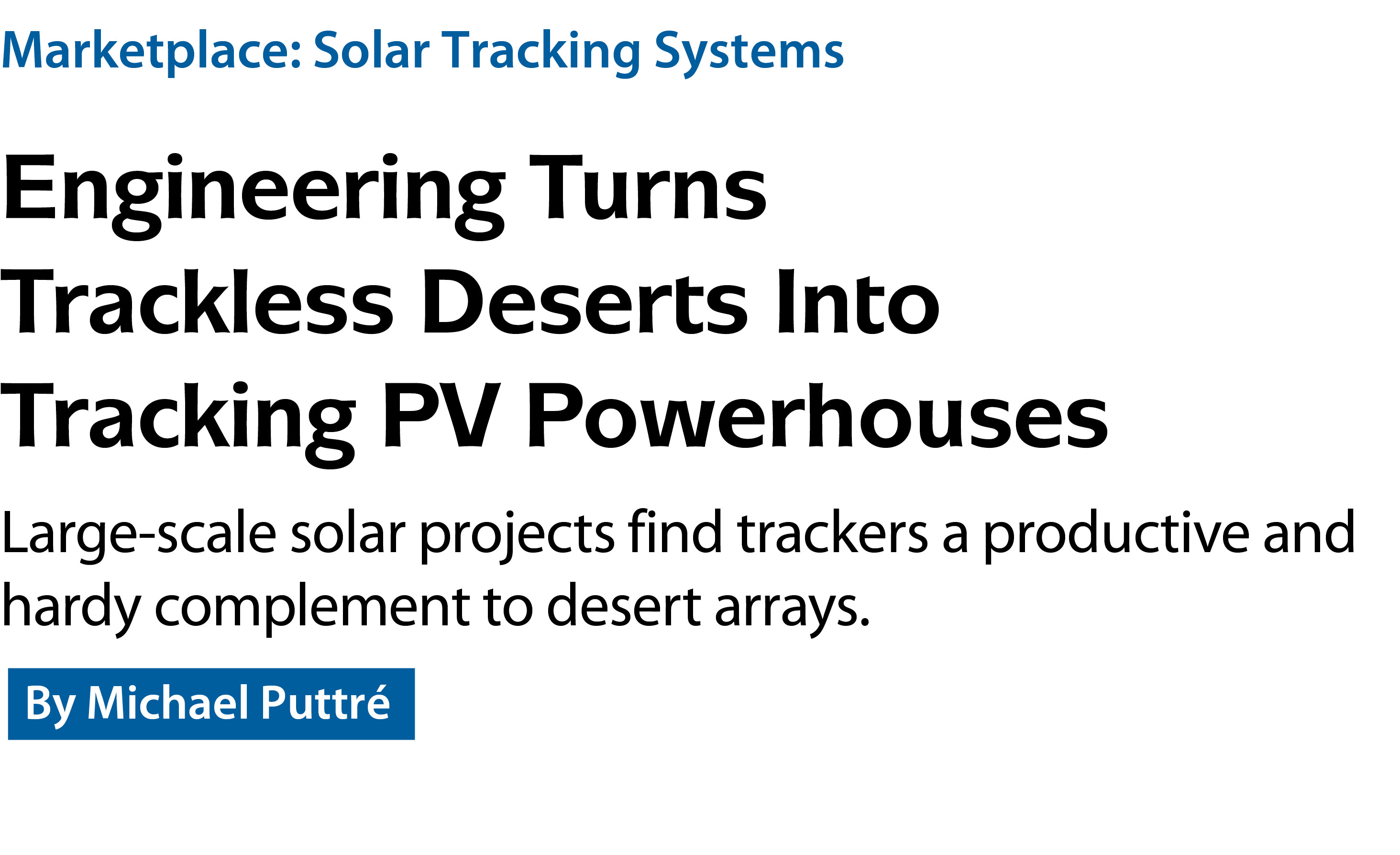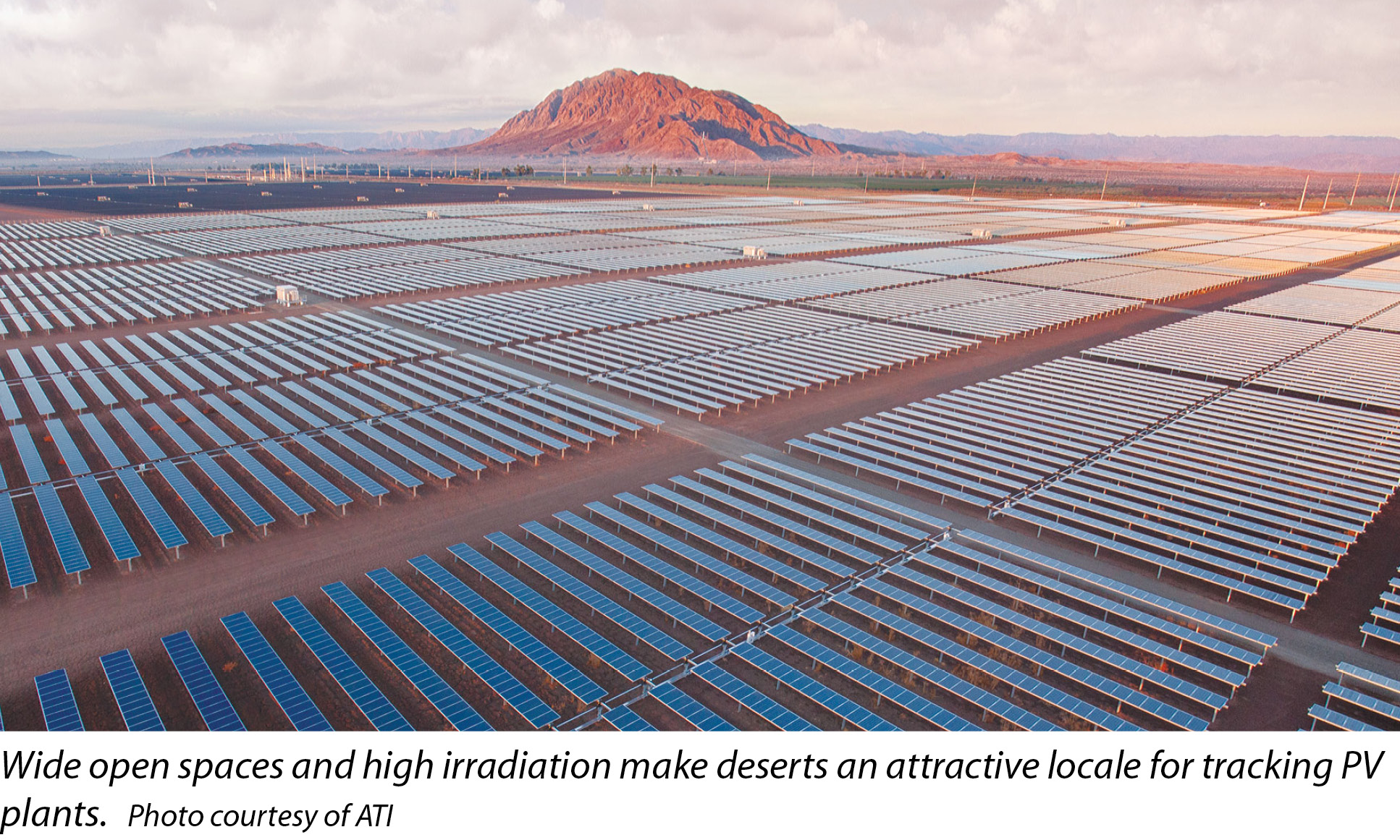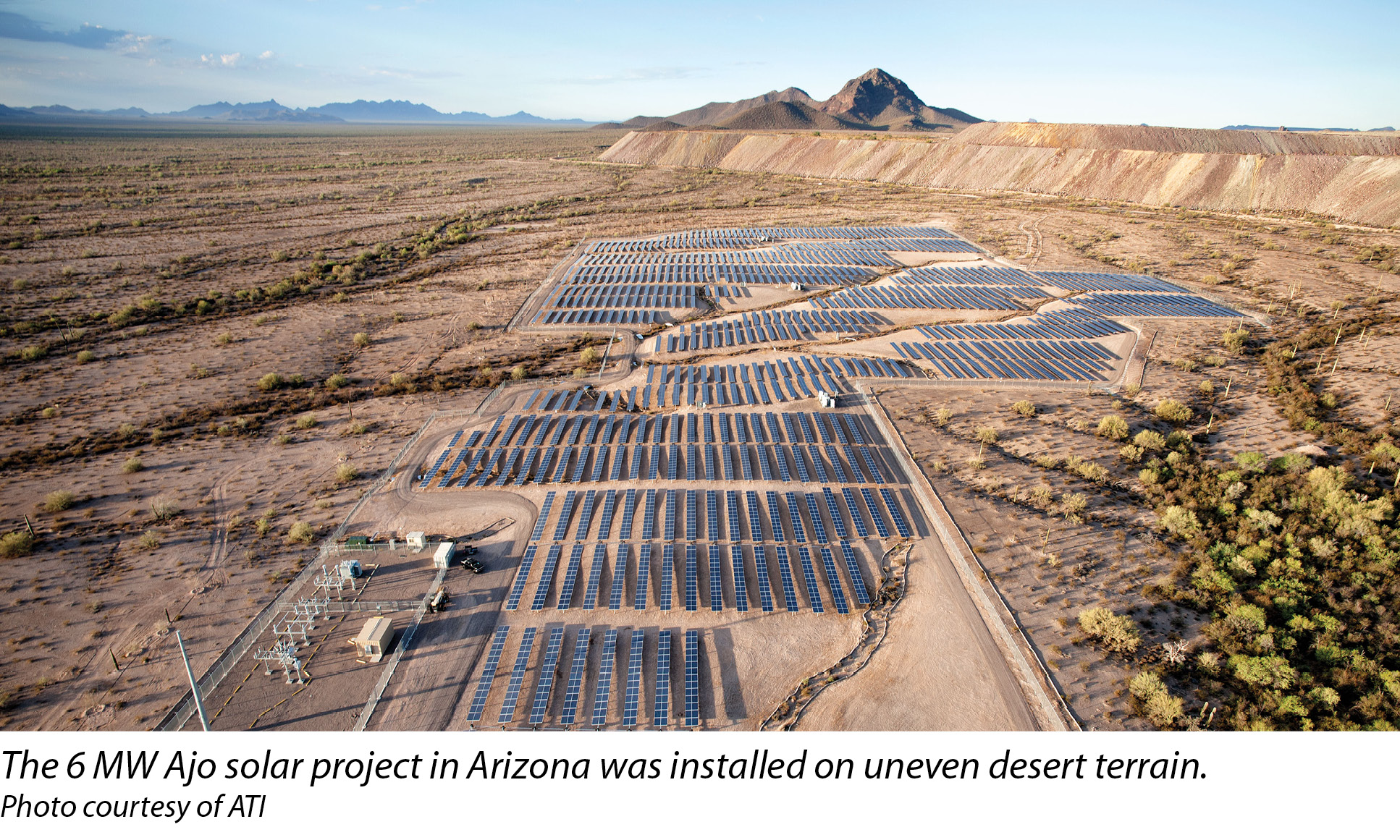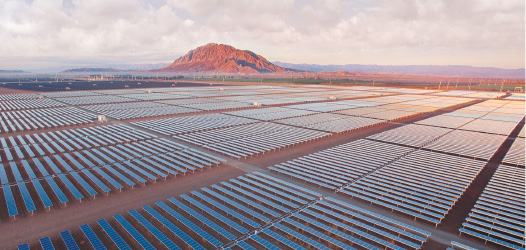

301 Moved Permanently
Despite some of the environmental opposition attending desert solar development (see “U.S. Species Plan Could ‘Zone Out’ Half Of California’s Desert Solar Potential”), the natural and demographic characteristics of such regions make them highly desirable. High irradiance values and the abundance of low-cost land combine to make deserts promising locations for large-scale solar projects.
The U.S. Department of the Interior’s Bureau of Land Management (BLM) has designated 285,000 acres of public land in Arizona, California, Colorado, Nevada, New Mexico and Utah as Solar Energy Zones. The BLM has a goal to approve 20 GW of renewable energy production on public lands by 2020. To date, the BLM has approved 28 solar projects as part of this program.
Outside the U.S., China’s Gobi, Chile’s Atacama, and vast stretches of the Middle East and North Africa regions represent some of the highest growth areas for large-scale solar.
On the move
At the same time, deserts are not a slam-dunk in terms of return on investment (ROI). Vaisala, a Finland-based environmental and industrial measurement firm, reports considerable solar irradiance variability, even in desert locations. For example, the company’s 3TIER business unit says solar irradiance has either exceeded or fallen short of expectations in 10 out of 15 summer months in Nevada over the past five years. Variations in solar irradiance caused by anomalous weather patterns could have a dramatic impact on solar asset production.
Trackers are one possible means of adjusting for such variability and maximizing output under variable conditions. According to Katerina Steck, a spokesperson for Mechatron-Solar Inc. in Redwood City, Calif., dual-axis trackers in areas of high yearly average irradiation (HT > 17 MJ/m2 day) provide at least a 39.5% increase in total long-term power generation compared to a fixed-tilt PV facility.

“Combining this energy improvement with the low cost of land usage makes the deployment of dual-axis trackers compelling for PV plants in the desert,” Steck says.
Jay Johnson, vice president of U.S. business development for France-based Exosun, says trackers significantly increase solar plant output in comparison to fixed-tilt structures for the simple reason that they enable panels to receive more direct sunlight.
“Deserts have very high irradiance resources all year long and very few clouds; therefore, trackers make particular sense in these areas,” Johnson says.
By way of example, he cites that a PV installation in Kenya equipped with the company’s Exotrack HZ horizontal single-axis trackers produces 25% more energy than would have been the case with a fixed-tilt installation.
According to Parikhit Sinha, director of environmental, health and safety at First Solar Inc., while tracking systems have slightly higher construction and operations and maintenance costs per watt than fixed-tilt systems due to the incremental tracking equipment and associated cabling, these costs are often easily justified by the improved specific yield of tracking systems, particularly in many desert regions (see “Tracking Systems Boost Eco-Efficiency,” SIM, November 2013). For example, First Solar reports up to 10% lower levelized cost per kilowatt in the southwest U.S.
“The primary markets for our Duratrack HZ product are in some of the hottest, most uninhabitable desert areas, specifically in the southwestern U.S.,” says John Williamson, lead engineer for Array Technologies Inc. (ATI) of Albuquerque, N.M. “Desert regions are most often in lower latitudes with high irradiance, which are particularly beneficial for horizontal axis tracking.”
Williamson says the path of the sun is most important to the tracker addition to ROI, which can be about 25% to 30% over fixed tilt in low latitudes.

Mechatron’s Steck points out that the benefits of trackers in desert climates extend beyond PV power plants. The same concepts can be applied in the concentrating solar power (CSP) domain, where large plants can generally only be developed economically in desert areas, where large tracks of land are available and almost constant high irradiance throughout the year allows the solar towers to supply steady high-temperature steam for the turbines.
“Actually, CSP plants can only be realized in desert areas with specific high-irradiance conditions,” she says. “Those regions are ideal for dual-axis thermal heliostat trackers.”
Daily grind
Of course, the very features that make deserts such wonderful locations for large-scale tracking solar power plants also imply some of the challenges for such facilities. The remoteness and extreme environmental conditions are hard on infrastructure, particularly facilities with mechanical moving parts.
Moreover, desert environments are notable not just for high temperatures, but for extreme temperature variability in the day-night cycle. These cycles, year-in and year-out, create the most significant demands on the system and call for the most important engineering considerations.
“The heat does not significantly affect tracker performance, but large temperature extremes pose challenges to tracker design for expansion and contraction of the metal in the tracker structure,” Williamson says.
Connections must be designed to accommodate up to 2 inches of movement in the most extreme cases, and mechanical components must be designed to not be rigid when they expand relative to one another. Particulates are challenging with any sort of moving parts, he says, because they accelerate wear on any surfaces that are not sealed to the elements.

“In cooperation with Boeing, we have tested our bushing materials for wear by performing lifetime testing with sand added to the bushings to ensure they will not wear out over the lifetime of the tracker,” Williamson says.
The 265 MW Mt. Signal solar project in California’s Imperial Valley employs ATI’s Duratrack HZ trackers and represents the company’s largest - and hottest - installations. Williamson reports that the site regularly reaches temperatures exceeding 100°F in the summer - with a record high of 122°F - while swinging down to below freezing in the winter.
“We have several hundred megawatts in very similar environments in Southern California and Arizona,” he says. “We also have a project being built in the Atacama desert in northern Chile, one of the driest climates in the world, at close to 10,000 feet above sea level.”
Mechatron, which produces extremely large pole-mounted tracking systems, relies on the inherent industrial durability of its machinery and enclosures as proof against the elements. Sensors and automation also enable the units to assume a “safe mode” in high wind conditions.
“The hydraulic system is similar to large earth-moving machinery,” Steck says. “It is sealed and isolated from the environment and is immune to dust, particulates and sand. In particular, our hydraulic system has been tested in temperatures of -20°C to +45°C. The tracker has a built-in self-protection mechanism that moves the platform to stow position under certain conditions, such as extreme winds and power outages.”
In windy conditions, the auto-protection mechanism consisting of an anemometer and software-driven electronics puts the tracker in a stow position, preventing damage. Taking measurements in regular-intervals from the field anemometer, the controller determines when extreme weather conditions are present and make the necessary hydraulic changes for stowing the platform to the horizontal safe position.
“The eccentric load of the main platform’s weight in reference to the main support column allows the platform to self-stow when these conditions apply, hence auto-protecting itself from damages,” Steck says.
Exosun’s Johnson says his company’s more modest-scale trackers are designed for the most extreme environments they would be expected to inhabit. This way, a specialized line of desert systems are not required.
In March, Exosun was selected by Abengoa and EDP Renewables to equip the 37 MW Lone Valley solar project in San Bernardino County, Calif., with Exotrack HZ single-axis trackers.
“In the desert, our Exotrack HZ trackers do not require any modifications,” Johnson says. “They were actually designed from the start to withstand extreme environmental conditions. Desert conditions may involve higher operating costs for the plant in terms of module cleaning and so forth, but not for the trackers.”
Johnson says the most critical tracker components regarding temperature are the Exobox central control-command system and the motors. These components are designed to operate in temperatures up to 50°C (122°F) and without lubricant.
“This feature not only reduces maintenance operations, but also largely limits particles sticking, such as sand and dust,” Johnson says.
In terms of wind resistance, the Exotrack HZ is rated to withstand winds up to 100 km/h in tracking mode and up to 200 km/h in the safety position.
“The wind resistance can be upgraded to 240 kilometers per hour with the addition of two piles on each table, with five piles in total,” Johnson says. “Trackers are automatically moved into safety position when a wind speed of 70 kilometers per or higher is registered.”
ATI’s Williamson says the desert represents the acme of design standards. By engineering its trackers to perform in a desert, he says, the company is able to handle most other extreme environments, such as tropical, maritime and snowy regions.
“Our standard tracker is actually designed specifically with the desert in mind, so we do not typically make any changes there,” he says. “The only special requirements we typically ask for are to mount the more sensitive electronics under a shaded location away from heat sources to prevent overheating.”
While manufacturers are confident their trackers are able to handle the extreme conditions deserts can dish out, Colleen O’Brien, manager of solar due diligence for San Ramon, Calif.-based engineering firm DNV GL, says deserts can always surprise you. DNV GL operates a field testing facility where it exposes solar components to a desert environment over long periods of time. Temperature and wind are sometimes the least of a solar developer’s worries.
“Flash floods are a real problem,” O’Brien says. “That water can come out of nowhere.” S
Marketplace: Solar Tracking Systems
Engineering Turns Trackless Deserts Into Tracking PV Powerhouses
By Michael Puttré
Large-scale solar projects find trackers a productive and hardy complement to desert arrays.


si body si body i si body bi si body b
si depbio
- si bullets
si sh
si subhead
pullquote
si first graph
si sh no rule
si last graph